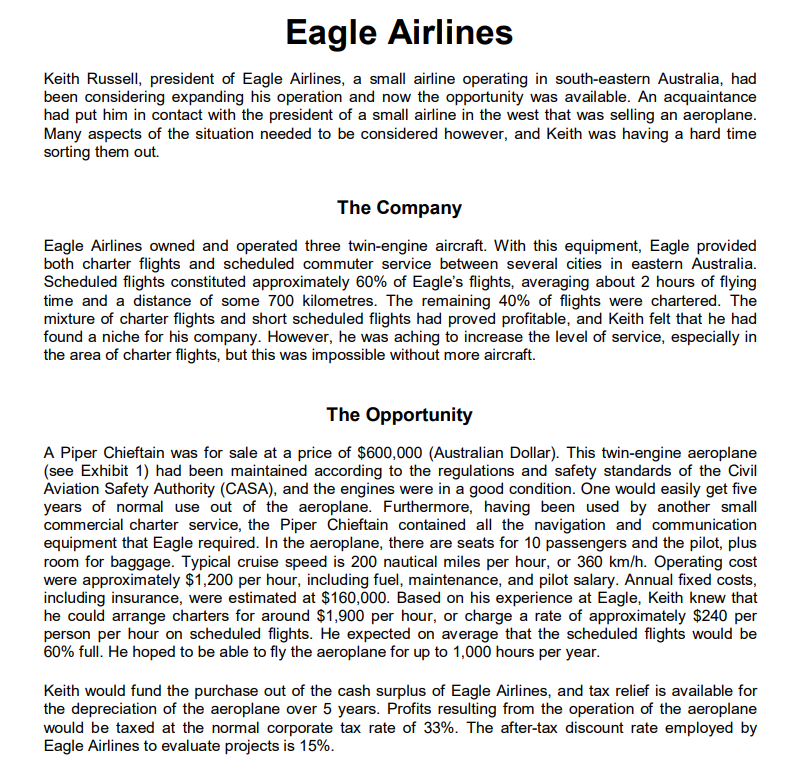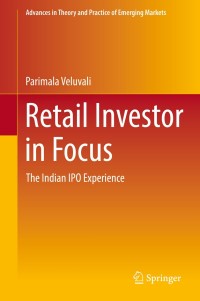Suppose that, using his best guesses, Keith Russell purchases the plane. What are the worst and best possible NPV values that Eagle Airline can get when the plane is purchased? Explain how you obtained these worst/best NPV values.

Eagle Airlines Keith Russell, president of Eagle Airlines, a small airline operating in south-eastern Australia, had been considering expanding his operation and now the opportunity was available. An acquaintance had put him in contact with the president of a small airline in the west that was selling an aeroplane. Many aspects of the situation needed to be considered however, and Keith was having a hard time sorting them out. The Company Eagle Airlines owned and operated three twin-engine aircraft. With this equipment, Eagle provided both charter flights and scheduled commuter service between several cities in eastern Australia. Scheduled flights constituted approximately 60% of Eagle's flights, averaging about 2 hours of flying time and a distance of some 700 kilometres. The remaining 40% of flights were chartered. The mixture of charter flights and short scheduled flights had proved profitable, and Keith felt that he had found a niche for his company. However, he was aching to increase the level of service, especially in the area of charter flights, but this was impossible without more aircraft. The Opportunity A Piper Chieftain was for sale at a price of $600,000 (Australian Dollar). This twin-engine aeroplane (see Exhibit 1) had been maintained according to the regulations and safety standards of the Civil Aviation Safety Authority (CASA), and the engines were in a good condition. One would easily get five years of normal use out of the aeroplane. Furthermore, having been used by another small commercial charter service, the Piper Chieftain contained all the navigation and communication equipment that Eagle required. In the aeroplane, there are seats for 10 passengers and the pilot, plus room for baggage. Typical cruise speed is 200 nautical miles per hour, or 360 km/h. Operating cost were approximately $1,200 per hour, including fuel, maintenance, and pilot salary. Annual fixed costs, including insurance, were estimated at $160,000. Based on his experience at Eagle, Keith knew that he could arrange charters for around $1,900 per hour, or charge a rate of approximately $240 per person per hour on scheduled flights. He expected on average that the scheduled flights would be 60% full. He hoped to be able to fly the aeroplane for up to 1,000 hours per year. Keith would fund the purchase out of the cash surplus of Eagle Airlines, and tax relief is available for the depreciation of the aeroplane over 5 years. Profits resulting from the operation of the aeroplane would be taxed at the normal corporate tax rate of 33%. The after-tax discount rate employed by Eagle Airlines to evaluate projects is 15%. The Analysis As Keith pondered this information, he realised that many of the numbers that he was using were estimates. Actually, there seemed to be a lot of uncertainty in most of the assumptions he made about his business, and he realised that these uncertainties may have a significant impact on the decision whether or not to purchase the new aeroplane. He therefore decided to investigate this a little further. Although the new aeroplane will certainly be operational for 5 more years, there is a chance that it can be used for one or two years more. However, given his experience in the past, Keith was not willing to take this risk, and only considered buying the Piper Chieftain if it could be profitable in 5 years. In the past, scheduled flights accounted for 60% of Eagle's flights. Keith believed that this might very well change however. Although 60% was still his best estimate of the future situation, the proportion may decrease to 40% or increase to 70%. Operating costs were fairly easy to predict, although they may vary a little. Keith estimated that his best guess of $1,200 could be wrong by $50 in either direction, mainly depending on fuel prices. Ticket and charter prices were partly under Keith's control, but were highly influenced by competitors' moves. Especially the charter prices were under high competitive pressures, resulting in Keith more or less matching the prices set by his major competitors. This resulted in a charter price in the range between $1,600 to $2,200 per hour. Keith had slightly more control over the ticket price per hour for scheduled flights, which would probably have to be around $240 per person, but could range up to extremes of $200 or $300, depending on market conditions. According to Keith, a delicate point was the utilisation of the scheduled flights, which was currently around 60%, and Keith saw no reason why that would change. However, he had experienced some variability in utilisation rates in the past, which he also expected to be there in the future. He therefore took into account that utilisation rates may turn out to be different, and range from lows of 50% to highs of 70%. However, the aeroplane utilisation rate will in part depend on the actual ticket price. A related issue was the total number of flight hours, driving the revenues. Keith hoped to be able to fly the aeroplane for up to 1,000 hours per year, but realised that 800 might be more realistic. The total number of flight hours depends mainly on the state of the economy. If things get really bad, 700 hours per year was a possibility, although remote, according to Keith. Keith was wondering how he should he assess the profits resulting from the purchase of the aeroplane, and incorporate all of the uncertainties involved in the decision. Two questions keep playing up in his mind: Is the Piper Chieftain worth buying? What are the major risks involved? Eagle Airlines Keith Russell, president of Eagle Airlines, a small airline operating in south-eastern Australia, had been considering expanding his operation and now the opportunity was available. An acquaintance had put him in contact with the president of a small airline in the west that was selling an aeroplane. Many aspects of the situation needed to be considered however, and Keith was having a hard time sorting them out. The Company Eagle Airlines owned and operated three twin-engine aircraft. With this equipment, Eagle provided both charter flights and scheduled commuter service between several cities in eastern Australia. Scheduled flights constituted approximately 60% of Eagle's flights, averaging about 2 hours of flying time and a distance of some 700 kilometres. The remaining 40% of flights were chartered. The mixture of charter flights and short scheduled flights had proved profitable, and Keith felt that he had found a niche for his company. However, he was aching to increase the level of service, especially in the area of charter flights, but this was impossible without more aircraft. The Opportunity A Piper Chieftain was for sale at a price of $600,000 (Australian Dollar). This twin-engine aeroplane (see Exhibit 1) had been maintained according to the regulations and safety standards of the Civil Aviation Safety Authority (CASA), and the engines were in a good condition. One would easily get five years of normal use out of the aeroplane. Furthermore, having been used by another small commercial charter service, the Piper Chieftain contained all the navigation and communication equipment that Eagle required. In the aeroplane, there are seats for 10 passengers and the pilot, plus room for baggage. Typical cruise speed is 200 nautical miles per hour, or 360 km/h. Operating cost were approximately $1,200 per hour, including fuel, maintenance, and pilot salary. Annual fixed costs, including insurance, were estimated at $160,000. Based on his experience at Eagle, Keith knew that he could arrange charters for around $1,900 per hour, or charge a rate of approximately $240 per person per hour on scheduled flights. He expected on average that the scheduled flights would be 60% full. He hoped to be able to fly the aeroplane for up to 1,000 hours per year. Keith would fund the purchase out of the cash surplus of Eagle Airlines, and tax relief is available for the depreciation of the aeroplane over 5 years. Profits resulting from the operation of the aeroplane would be taxed at the normal corporate tax rate of 33%. The after-tax discount rate employed by Eagle Airlines to evaluate projects is 15%. The Analysis As Keith pondered this information, he realised that many of the numbers that he was using were estimates. Actually, there seemed to be a lot of uncertainty in most of the assumptions he made about his business, and he realised that these uncertainties may have a significant impact on the decision whether or not to purchase the new aeroplane. He therefore decided to investigate this a little further. Although the new aeroplane will certainly be operational for 5 more years, there is a chance that it can be used for one or two years more. However, given his experience in the past, Keith was not willing to take this risk, and only considered buying the Piper Chieftain if it could be profitable in 5 years. In the past, scheduled flights accounted for 60% of Eagle's flights. Keith believed that this might very well change however. Although 60% was still his best estimate of the future situation, the proportion may decrease to 40% or increase to 70%. Operating costs were fairly easy to predict, although they may vary a little. Keith estimated that his best guess of $1,200 could be wrong by $50 in either direction, mainly depending on fuel prices. Ticket and charter prices were partly under Keith's control, but were highly influenced by competitors' moves. Especially the charter prices were under high competitive pressures, resulting in Keith more or less matching the prices set by his major competitors. This resulted in a charter price in the range between $1,600 to $2,200 per hour. Keith had slightly more control over the ticket price per hour for scheduled flights, which would probably have to be around $240 per person, but could range up to extremes of $200 or $300, depending on market conditions. According to Keith, a delicate point was the utilisation of the scheduled flights, which was currently around 60%, and Keith saw no reason why that would change. However, he had experienced some variability in utilisation rates in the past, which he also expected to be there in the future. He therefore took into account that utilisation rates may turn out to be different, and range from lows of 50% to highs of 70%. However, the aeroplane utilisation rate will in part depend on the actual ticket price. A related issue was the total number of flight hours, driving the revenues. Keith hoped to be able to fly the aeroplane for up to 1,000 hours per year, but realised that 800 might be more realistic. The total number of flight hours depends mainly on the state of the economy. If things get really bad, 700 hours per year was a possibility, although remote, according to Keith. Keith was wondering how he should he assess the profits resulting from the purchase of the aeroplane, and incorporate all of the uncertainties involved in the decision. Two questions keep playing up in his mind: Is the Piper Chieftain worth buying? What are the major risks involved








